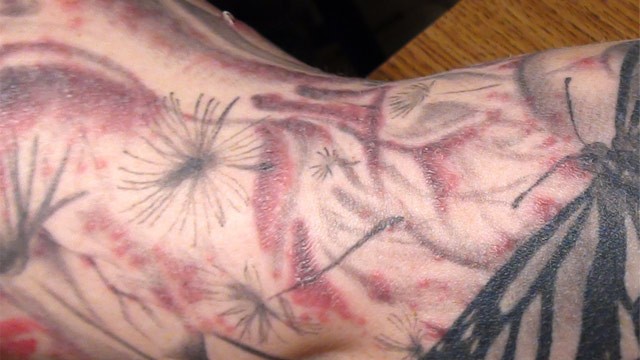This trail began when the man received a tattoo in Rochester, N.Y. in October 2011. A short while later, he noticed the raised, bumpy rash. He called his primary care physician.
Doctors initially treated the man's arm with topical steroids, thinking that the rash was allergic-contact dermatitis. But that only made the problem worse.
By the time dermatologist Dr. Mark Goldgeier saw the patient, it was clear that this was no simple allergy.
He performed a skin biopsy so he could take a closer look at the rash under a microscope. What he saw was startling: the sample was riddled with a wormlike bacterium related to tuberculosis.
"I explained [to the patient] that he had TB, and he had a look of horror on his face," Goldgeier said.
For the patient, the finding meant a trip to an infectious disease specialist to start up to a full year of treatment.
Goldgeier, meanwhile, called the Monroe County Health Department.
"As soon as biopsy came back," he said, "I knew something in the process of tattooing was involved -- the ink, the water used for dilution, the syringes, the dressings."
And so began a nationwide medical mystery.
An article published Wednesday in the New England Journal of Medicine describes how this one dermatologist helped connect the dots in an outbreak of tattoo-related atypical skin infections.
Dr. Byron Kennedy, public health specialist at Monroe County Department of Public Health, took over the case from Goldgeier. Kennedy first confirmed the results by repeating a skin biopsy on the patient. Once again, tendrils of mycobacterium chelonae, a type of tuberculosis-related skin bacteria, showed up in the sample.
Mycobacterium chelonae is a rapidly growing bug found in soil, dust, water, animals, hospitals, and contaminated pharmaceuticals. This family of bacteria does not commonly affect healthy individuals, but in patients with suppressed immune systems -- like those with HIV or on chemotherapy -- these bacteria can cause serious disease, often resulting in death.
The finding sent Kennedy and his associates to the tattoo parlor where the patient had been inked. Everything in the clinic was sterile, which made it unlikely that the infection had arisen there. But the tattoo artist, they learned, had been using a new gray premixed ink purchased in Arizona in April 2011; he used the ink between May and December 2011.
The ingredients of the ink -- pigment, witch hazel, glycerin, and distilled water -- seemed innocuous enough. But further examination revealed that the distilled water in the pigment was the likely culprit of the contamination.
The finding raised a number of questions -- not the least of which was how the bottles of premixed ink passed U.S. Food and Drug Administration regulations.
The U.S. Centers for Disease Control and Prevention acknowledged this gap in regulations Wednesday in its Morbidity and Mortality Weekly report.
"Under the Federal Food, Drug, and Cosmetic Act, tattoo inks are considered to be cosmetics, and the pigments used in the inks are color additives requiring premarket approval," the report says.











